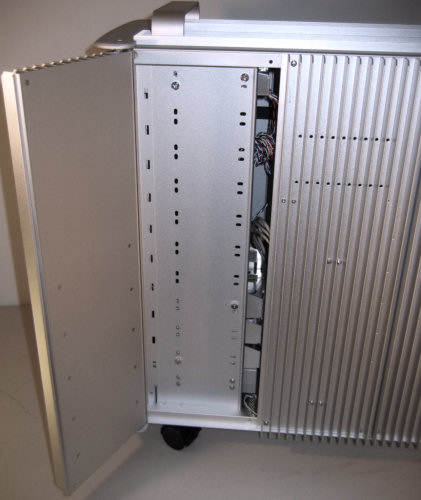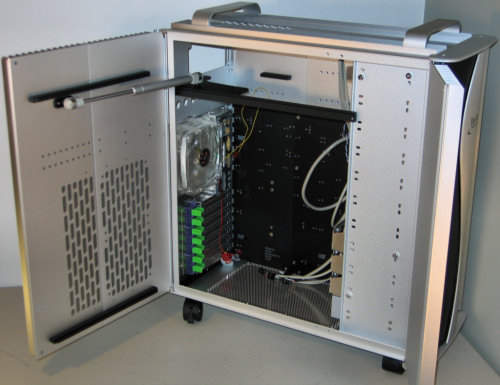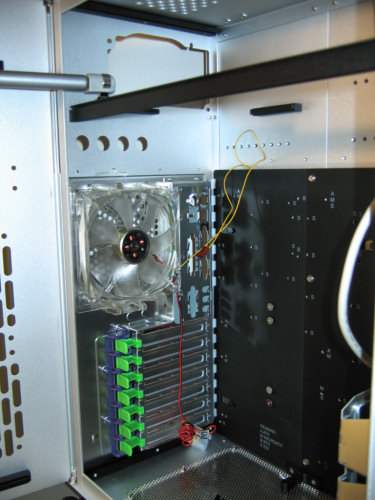Clash of the Titans - TT Tai Chi vs. CM Stacker 830
by Joshua Buss on February 23, 2006 12:05 AM EST- Posted in
- Cases/Cooling/PSUs
Thermaltake Tai Chi (cont’d)
To keep the case as tool-less as possible, Thermaltake simply chose to use thumbscrews to secure drives into the 5¼” bays. While this requires opening the right side of the chassis, there are a couple reasons why this isn't as much of a problem with the Tai Chi as it is with most cases.
First, this area of the case can open entirely on its own as shown in the picture above, which we found that it actually makes for an excellent place to hide additional cables, ensuring tidiness in the rest of the PC. More importantly, however, the Tai Chi's free-turning casters make turning the case a cinch, so access isn't as big of a deal. Two of the same large extended thumbscrews mentioned previously are used to hold this latch secure when closed.
The left side of the case is where the real attraction on the Tai Chi comes though. Here, a hydraulic arm is used to actively swing the oversized access door open, which simply consists of two of the solid passive vent-lined panels connected with the black solid aluminum bars visible in the above picture. The third panel on the left side opens as well, mirroring the panel on the right side that was just discussed.
This active opening mechanism has its own benefits and drawbacks; in using the case, the main advantage to this approach that we've found is that it stays fully open when working inside. Besides that, and the “wow factor“ of showing off the case, there's not much of a reason to incorporate the arm; especially if lots of equipment are installed to the inside of the door, a forceful opening might not be what the user desires. However, if preferred, the entire hydraulic assembly can be removed without hurting any other functionality.
The front of the case is exceptionally accessible, thanks to this dual-door design. Notice how there's another area here between the forward door and the drive bays (about one full inch in width) that could be used for any number of things. This picture is also a decent shot of the bottom mesh and motherboard tray, and also gives one an idea of how neatly they can route the cables from the top-mounted external ports, considering their plentiful length.
Focusing on the inside rear of the case, we find one of the only two main active cooling components, a Thermaltake 120mm blue LED fan. These fans move plenty of air without making enough noise to even really notice that they're on, especially if controlled to use slightly less voltage than the standard 12v.
The punch outs for 3/8” OD water tubing are also visible, as are the same tool-less expansion card locking mechanisms found on the Eclipse, which was recently reviewed by AnandTech. One frustration with this particular scheme is that they can be very difficult to unclip with certain cards. A SoundBlaster Audigy for instance made it darn-near impossible to unclip the green part in our test system due to a bolt on the card as seen here.
We'd prefer here if Thermaltake had simply opted for large thumbscrews like what other manufacturers are doing for the expansion cards. Take comfort though that this is pretty much the only complaint that we have with the Tai Chi after working with it for several days.
The spaces between the PSU area, crossbar, and motherboard assembly are all generous and, combined with the wide-opening dual doors, make working in the case a real pleasure. One last point of interest in this picture is the slots in the motherboard tray near the rear – they're not just at the bottom, indicating yet again that the case is truly designed and ready for BTX motherboards.
To keep the case as tool-less as possible, Thermaltake simply chose to use thumbscrews to secure drives into the 5¼” bays. While this requires opening the right side of the chassis, there are a couple reasons why this isn't as much of a problem with the Tai Chi as it is with most cases.
First, this area of the case can open entirely on its own as shown in the picture above, which we found that it actually makes for an excellent place to hide additional cables, ensuring tidiness in the rest of the PC. More importantly, however, the Tai Chi's free-turning casters make turning the case a cinch, so access isn't as big of a deal. Two of the same large extended thumbscrews mentioned previously are used to hold this latch secure when closed.
The left side of the case is where the real attraction on the Tai Chi comes though. Here, a hydraulic arm is used to actively swing the oversized access door open, which simply consists of two of the solid passive vent-lined panels connected with the black solid aluminum bars visible in the above picture. The third panel on the left side opens as well, mirroring the panel on the right side that was just discussed.
This active opening mechanism has its own benefits and drawbacks; in using the case, the main advantage to this approach that we've found is that it stays fully open when working inside. Besides that, and the “wow factor“ of showing off the case, there's not much of a reason to incorporate the arm; especially if lots of equipment are installed to the inside of the door, a forceful opening might not be what the user desires. However, if preferred, the entire hydraulic assembly can be removed without hurting any other functionality.
The front of the case is exceptionally accessible, thanks to this dual-door design. Notice how there's another area here between the forward door and the drive bays (about one full inch in width) that could be used for any number of things. This picture is also a decent shot of the bottom mesh and motherboard tray, and also gives one an idea of how neatly they can route the cables from the top-mounted external ports, considering their plentiful length.
Focusing on the inside rear of the case, we find one of the only two main active cooling components, a Thermaltake 120mm blue LED fan. These fans move plenty of air without making enough noise to even really notice that they're on, especially if controlled to use slightly less voltage than the standard 12v.
The punch outs for 3/8” OD water tubing are also visible, as are the same tool-less expansion card locking mechanisms found on the Eclipse, which was recently reviewed by AnandTech. One frustration with this particular scheme is that they can be very difficult to unclip with certain cards. A SoundBlaster Audigy for instance made it darn-near impossible to unclip the green part in our test system due to a bolt on the card as seen here.
We'd prefer here if Thermaltake had simply opted for large thumbscrews like what other manufacturers are doing for the expansion cards. Take comfort though that this is pretty much the only complaint that we have with the Tai Chi after working with it for several days.
The spaces between the PSU area, crossbar, and motherboard assembly are all generous and, combined with the wide-opening dual doors, make working in the case a real pleasure. One last point of interest in this picture is the slots in the motherboard tray near the rear – they're not just at the bottom, indicating yet again that the case is truly designed and ready for BTX motherboards.
















55 Comments
View All Comments
BubbaJudge - Thursday, February 23, 2006 - link
I was wafting between the Tai Chi and the Koolance PC3-725BK based on the Lian Li PC-V1000, it would have been great to include both watercooled versions for review, but great review regardless. I think I will go with the Koolance, as I agree the Tai Chi looks a little heat sink gimmicky. Hopefully I can stuff a PC P&C 850 in the Lian Li chassis.chynn - Thursday, March 2, 2006 - link
The PCP@C 850W might not fit in the Lian-Li V1000 case; however, it will definitely fit in the Lian-Li V1200 case. I have the latter Lian-Li case but will be replacing it with RC-830 Stacker case ... the RC-830 case is just that much better.mkruer - Thursday, February 23, 2006 - link
Call me old fashion but I like the simple designRip the Jacker - Thursday, February 23, 2006 - link
first.tuteja1986 - Thursday, February 23, 2006 - link
I am buying Cool Master Stacker now :) . its an awesome case and goes arround $200AUD in Australia. I am going to use 2 PSU 480W antec and 550W antec. Go full crossfire when i sell my Asus A8N SLI-32 and buy either a RD580 mobo from ABit or ASUS or DFI.